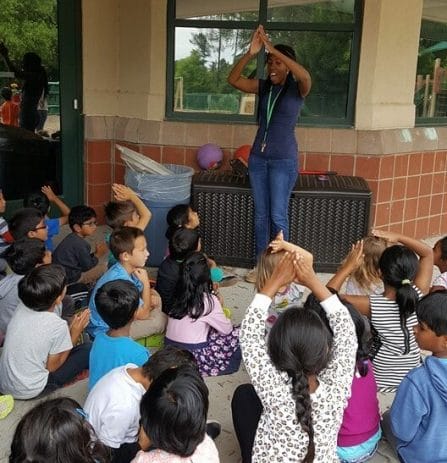
The author with her students.
February 27, 2022
By Jaqueta Abbey, Teaching and Learning Specialist
As a first-grade teaching assistant, I’m currently experiencing just how exhausting it is to be in the classroom right now. First grade is such a BIG year for children: they’re learning fundamental reading skills, learning to interpret social cues, and figuring out what it means to be human. Oh, and all of this happens while their teeth are falling out all over the place. Add having life as they’ve known it completely upended due to the pandemic to the list and it’s no wonder why my lead teacher and I are encountering more frequent unwanted behaviors in the classroom!
Center for Inspired Teaching’s February Institute, “The HeART of Discipline,” couldn’t have come at a better time. Over the course of two hours, participants (including myself) used improvisational activities, guided self-reflection, and collaborative brainstorming to dive deeper into a student-centered approach to navigating challenging behaviors.
The session began with a series of stretches to loosen up our bodies and minds, as well as introduce participants to the core of Inspired Teaching’s approach, the 4 I’s: Intellect, Inquiry, Imagination, and Integrity.
After the warm-up, we engaged in the following activities to help us explore what we want discipline to look like, identify student needs that aren’t being met, and break through stagnant thought patterns.
- Two Kinds of Discipline – We used our imaginations to first brainstorm what “discipline” meant to us in relation to the classroom. Then, we thought about what the word might mean to an artist and made comparisons. We realized we want to incorporate more of the positive associations of the word into the classroom or home.
- Point and Name – By naming items in our surroundings, then making a conscious effort to name them something completely different, we discovered how difficult it is to break old habits and thought patterns.
- Reflecting on Student Behavior with ABCDE – We defined ABCDE, the core needs that must be met in order for someone to be motivated to learn. We then took time to reflect on a student who performed an unwanted behavior and thought about which of the student’s needs were not being met.
- To Not For With – We learned how to reframe our responses to unwanted behaviors by incorporating ABCDE and practiced with a scenario. The goal of this activity was to identify punitive, neglectful, and/or permissive responses and move away from them in favor of a restorative approach.
- Sunshine vs. Up All Night Students – For our final activity, we used reflection sheets to jot down thoughts about a student who brings us joy (“sunshine student”) and a student who keeps us up all night, then shared some observations about what we noticed.

Finally, we closed out the session by sharing one thing we intended to try in our classroom. With the wealth of information presented, it was a little overwhelming to declare how I intended to reconfigure discipline in my classroom right on the spot. But every change in habit begins with one tiny, mental shift. My lead teacher gently reminds our students, “You’ve only been on this Earth for six years. That’s not a long time!”
Sometimes, I think we adults need that reminder too. We’ve been on the Earth for longer than our students, but as educators, we should be committed to continuously learning and growing. I love that Inspired Teaching’s Institutes give us the space to do so, and in a creative, engaging way.
